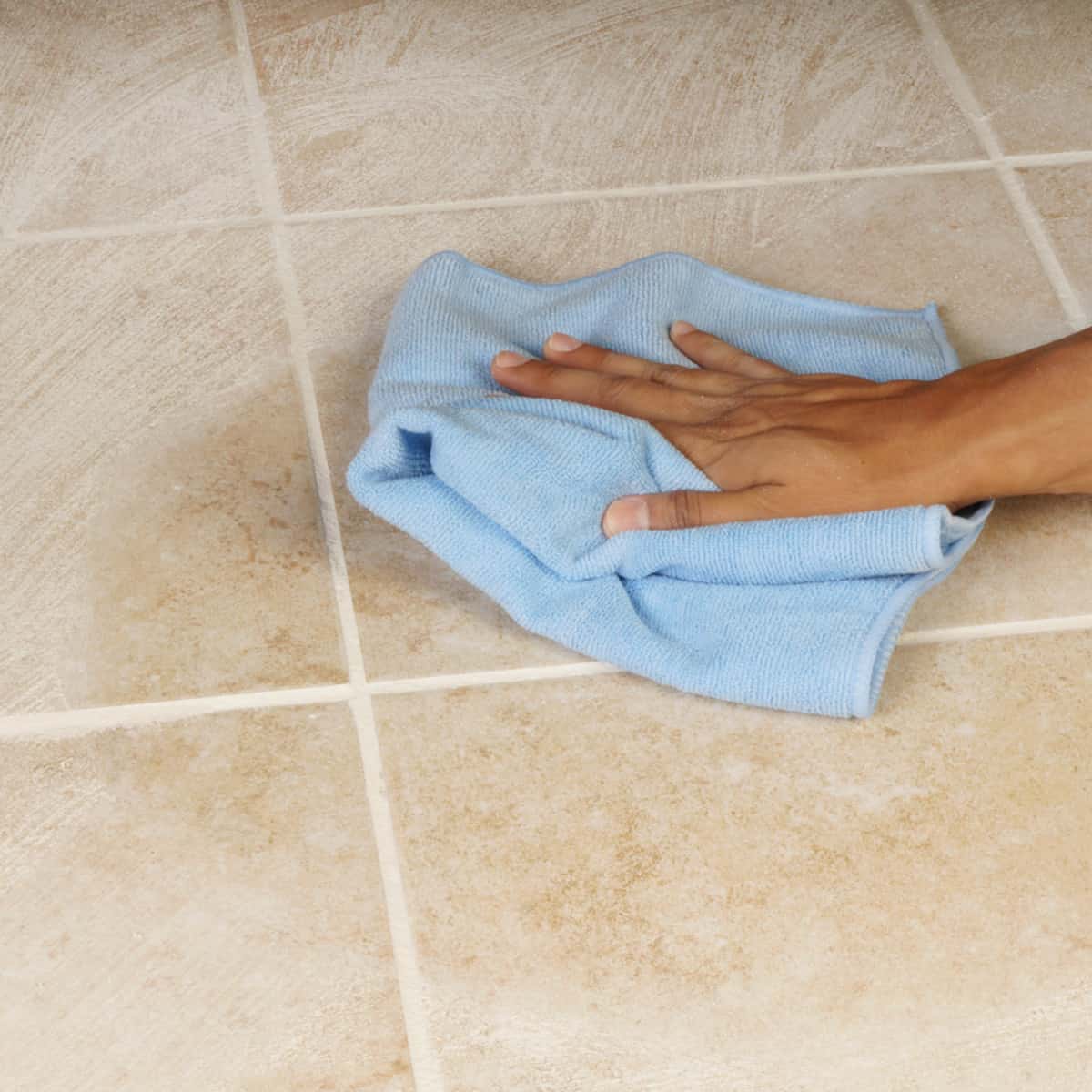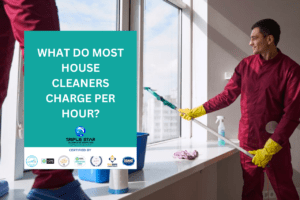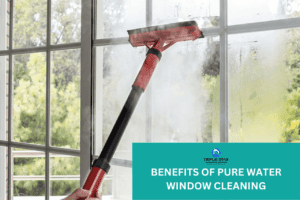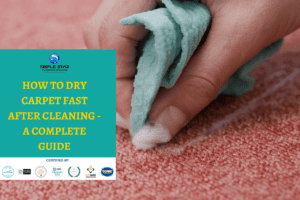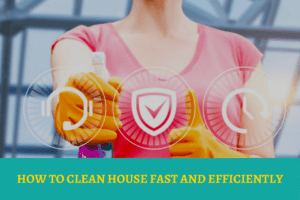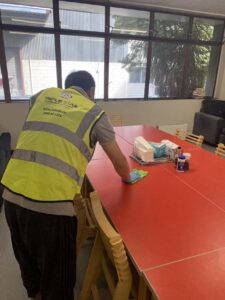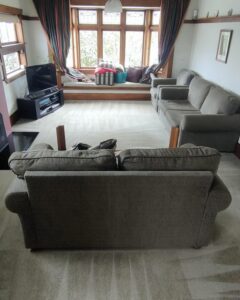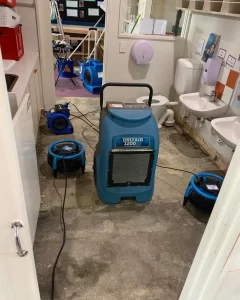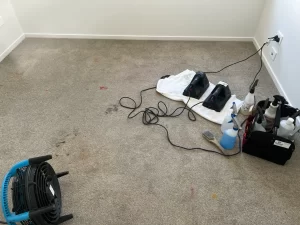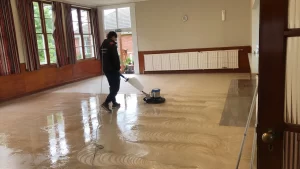Who loves walking on a sticky floor? Well, I don’t! But of course, you can not help stickiness, especially if you have a kid at home. Luckily, cleaning the sticky tile floors is really easy and quick with the right method.
To clean a sticky tile,
- Vacuum the floor first and remove any loose residue with a scrapper.
- Mop away the stickiness with prepared water and tile cleaner (vinegar, baking soda, soap, etc.).
- Rinse the floor with fresh water and let the tile air dry.
Can you use any cleaning solution on the tiles? Well, no! You need to select the cleaner composition according to the flooring type. More details are discussed below.
Table of Contents
ToggleBasics Of Cleaning Any Sticky Floor Tiles
Cleaning the sticky tiles is a cup of tea if you know the tricks and have the right equipment. The necessary supplies for floor maintenance are,
- Vacuum
- Mop
- Clean floor cleaning rag
- Bucket
- Soft towel
- Water
- Tile cleaner
After collecting all these materials, move to the cleaning stage. The ideal steps to remove tile floor stickiness are,
- Vacuum or brush away the dirt from the floor first.
- Use baking soda and vinegar paste to scrape any hard stains from the tiles. You can use commercial products for this purpose too.
- Next, fill the bucket with warm water and pour the cleaning agent. Vinegar, lemon juice, baking soda, mild soap, etc., are popular and harmless tile cleaning ingredients. Using commercial tile cleaners is also an option.
- Mix the solution properly and let the mop/rag soak the mixture. Then wring out the excess solution from the mop head.
- Now wipe off the sticky tiles with the mop/rag.
- Wring out the dirty water and damp the rag in the solution again.
- You may need to prepare another bucket of cleaning solution if the prior one gets dirty.
- Once the floor is glowing, rinse the tiles with clean water to remove the residuals.
- Pat the floor with a soft, dry towel to remove excess water.
- Finally, let the tiles air dry naturally.
Polishing the floors with additional ingredients for extra shine is a good idea. Allow the polishing agent to sit on the tiles for some time. Then dab away the solution with a damp cloth later.
Specialized Cleaning Technique For 10 Different Flooring
Take any random tiles. The stickiness removal method is more or less the same. Yes, the cleaner or the solution composition and quantity change with the tile types.
In this section, I will only focus on the suitable and safe cleaning agents for a variety of tiles. For example,
1. Natural Stone/ Slate Tiles Floor
- Select a pH-neutral dish soap and mix it with a bucket of water. Avoid acidic or basic cleaners, which can damage the stone’s shine.
- Stir the mixture well.
- Soak a rag or a mop in the soapy solution and wipe out the stickiness from the stone floor.
- Rinse off the detergent streaks from the tiles with lukewarm water.
- Once the tiles are dry, you can use salt, extra-virgin wax, or self-shining wax to add shine to the floors. Take the salt on a damp cloth and rub it on the tile until the towel gets dry. Avoid excess salt or wax for more shine as it will only make the floor yellow.
- Other solutions aid in removing stone tile spots and grouts are vinegar, ammonia, lemon juice and salt, baking soda, etc. Natural stone soaps and cleaners are also available in the market.
2. Ceramic Tiles Floor
- Vacuuming and removing any residual is important before starting the cleaning process. You can use a plastic putty knife to scrape the sticky dried stains from the floor.
- Next, prepare a cleaning solution with vinegar (1/2 cup), pH-neutral dish soap (1/2 tablespoon), and a bucket of warm water. You can avoid the soap by using 1 cup of white vinegar instead of half.
- Now mop the ceramic tiles with the soapy vinegar solution.
- Once the stickiness is gone, use plain hot water to rinse the floor.
- Finally, air dry or towel dry the tiles right away.
3. Porcelain Tile Floor
- The best part of porcelain flooring is that it requires minimum maintenance and cleaning. For example, regular mopping the tiles with a detergent solution will do the job. Mix 2 tablespoons of detergent in 4 liters of warm water to prepare the cleaner at home.
- You can use mild soap or a commercial porcelain floor cleaner instead of detergent.
4. Vinyl Tiles Floor
- White vinegar or apple cider vinegar in warm water will remove any residue from the vinyl floor.
- Adding pH-neutral dish soap to the mixture also helps cut through the grime.
- A few drops of baby oil or extra virgin oil in the vinegar-water solution adds shine to the vinyl tiles.
- Vinyl floor-specified cleaners are also available. But the chemicals can be proven damaging in the long run.
5. Linoleum Tiles Floor
- 1 cup of vinegar, a few drops of dish soap, and 1 gallon of warm water are enough to clean the linoleum floor tiles.
- Baking soda paste made with lukewarm water is also a good cleaner for linoleum floors.
- Acidic or basic chemical solutions like ammonia or bleach take away the charm of the tile. But you can use linoleum cleaners to remove the stickiness. Just add 6 – 7 drops of the solution to warm water and mop the floor.
- Dabbing the tiles with polishing mixture aids in restoring the lost shine.
6. Glass Tile Floor
- More or less, we all use commercial cleaners to remove the stickiness from the glass tiles. However, you can also use the vinegar and water mixture as a homemade alternative.
- Available ingredients that also help clean the glass tiles are baking soda, rubbing alcohol, and nail polish remover.
- Glass tile floors are not good at abrasion resistance. Hence, only select the soft-bristled brush, mop or towel for cleaning.
7. Granite Tile Floor
- A mixture of mild dishwashing detergent and water is enough to remove the granite floor stickiness. You can also wipe off the tiles with baking soda (1/4 cup) and water (3 cups) paste.
- After mopping with the baking soda or detergent, dab away the floor with rubbing alcohol and water for glossiness.
- However, you can use rubbing alcohol as the main cleaner too. Mix rubbing alcohol (1 cup), dish soap (1 tablespoon), and warm water (1 ½ cups) to prepare the granite cleaner.
8. Rubber Tile Floor
- The ideal solution to clean the rubber tiles includes 1 bucket of warm water and 60 ml of dish soap. You can replace the soapy liquid with an equivalent amount of detergent. Make sure either ingredient is pH neutral, as acidic or basic chemicals are a curse for rubber tiles.
- If the tile has stubborn stains, prepare a vinegar solution. Add 50% of white vinegar to 50% warm water.
- You can use a Turpin to lift oil-based stains or stickiness from the rubber floors. Only 3 tablespoons of Turpin on a dry cloth is enough to blot away the stains. Likewise, go for paint thinner to wipe off any ink or paint-based spots. Wear gloves when handling these chemicals.
- Regular maintenance of the rubber tiles reduces their stickiness. Vacuuming every week and deep cleaning every 6 months is recommended. However, avoid cleaning your newly installed rubber tiles for at least 72 hours. The rubber flooring is soft at first and gains durability over time.
9. Cork Tile Floor
- Cork tiles are available in 2 types, one with polyurethane sealed and another unsealed. You can use water and mild detergent/ vinegar solution as cleaner in both types.
- A layer of wax is required after the rinsing and drying of the unfinished cork tiles.
10. Marble Tile Floor
- Marble tiles are more sensitive to chemical solutions than other floorings. So, pH-neutral cleaning agents are recommended.
- Diluted soapy water or saturated ammonia are recommended for a homemade cleaning solution. 1/2 cup of ammonia or mild soap in 1 bucket of water will prepare the ideal cleaner. Do not use pure ammonia or hydrogen peroxide to clean the marble tiles.
- Baking soda paste also has the potential to wipe clean the marble tiles with zero damage. Another possible cleaning agent for marble flooring is a rubbing alcohol and water mixture.
- Once your marble tiles are cleaned and dried, pat a layer of talcum powder and vegetable oil on the floor. This will add shine to the tiles, removing any sticky residue.
- Do not forget to rinse off the entire flooring to eliminate both cleaning and polishing agents.
How To Clean The Sticky Tile Grout?
Even the tile grouts can not escape the stickiness. In fact, the stains and the gluey effects are more prominent on the grouts. But luckily, a gentle cleanser eliminates any residue or spots from these tile-bonding fillers.
For example, mix vinegar and water in equal parts in the bucket. Use the solution to brush away the stickiness of the grouts. Likewise, you can scrub away stubborn stains with baking soda and vinegar paste.
Be gentle when rubbing off the stain or stickiness from the grouts. The fillers are fragile and may come off if you are too harsh.
Finally, wipe off the grouts with a damp cloth, followed by a dry towel pat. The grout will shine like new once dried.
Why Is My Tile Always Sticky?
Overwelcomg any spill can obviously make your floor sticky. But it is not the only reason. 6 more factors that can cause a sticky floor are,
1. No Sense Of Hygiene
Sorry for the harsh words! But your unhygienic habit may be why the tiles are so sticky.
Letting the dirt and stains linger on the tiles for a long time will cause stickiness. Also, you need to vacuum the floor before mopping. Otherwise, the cleaner and dirt will sit on the floor in the form of a gluey substance.
2. Poor Maintenance Routine
Regular tile maintenance, at least twice a week, is always recommended. Not following this routine accumulates dirt and stain, causing the tile stickiness.
Moreover, the maintenance kits also play a role in this. For example, a dirty bucket and unwashed mophead or sponge will only make the tile condition worse.
3. Improper Cleaner Selection
I agree vinegar and baking soda act as universal tile cleaners. But when you go for chemicals or commercial products, make sure those suit the tile. A poor cleaner selection or using a clone of a well-known product with different ingredients can also cause sticky tile flooring.
4. Have You Changed The Water?
You can not wipe out the entire floor with only a bucket of water. Soon the solution will get dirty, turning the further cleaning into a mess.
Think of it this way. By mopping with the muddy water, you are not cleaning, but moving the dirt around. So, why will the tiles not be sticky?
5. Not The Right Quantity
Pouring the cleaning ingredient in bulk does no good to the tiles, but the opposite. For example, too much soap in the water leaves a sticky residue behind. So, reading the cleaner instructions when preparing the solution is important.
6. Incomplete Steps
I have already mentioned that you can not leave the cleaning residuals behind on the tiles. It not only damages the floor surface but also causes stickiness. So, always finish the wiping followed by a water rinse or damp cloth dab.
3 Ways To Prevent Your Tiles From The Stickiness
It takes a minimum effort to keep the stickiness away from the floor. Following the basic cleaning and maintenance instructions per the floor type is enough. To be more specific, you can avoid the tile stink by adopting the following tricks,
1. Know How To Clean The Tile
Do not just use any cleaner on your tiles. Instead, do some self-study and research to find the best floor-cleaning solution. For homemade cleaners, always maintain the right ingredient proportion.
2. Regular Maintenance Is Necessary
I am not telling you to mop the tiles every day. But vacuum the dirt from the floor at least once every other day. Likewise, wipe off the tiles at least twice a week.
Also, dab away any spills from the floor almost immediately. Use a stain remover right away if necessary.
3. Steaming Mop Helps!
Switching to a steaming mop can put an end to the tile stickiness. The hot vapor really helps loosen the residual and then wipes them away. But yes, the steam can weaken the grout bonding to the tiles, which is a big downer of these mops.
However, you can always use a microfiber mop as an alternative.
Conclusion
The water with mild detergent, dish soap, vinegar, or baking soda makes the perfect cleaning solution for tile stickiness. These mixtures also work to remove stains from the floor. You should avoid any harsh chemicals with high basicity or acidity that can ruin the tile’s integrity. Don’t have any time to clean your floor. Contact Triple Star Commercial Cleaning Service now for getting the best professional floor cleaning experience at your doorstep.

